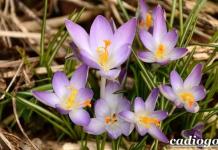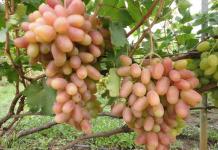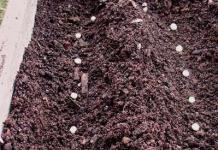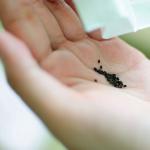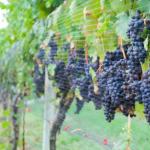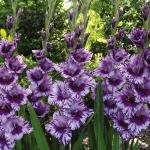The cultivation of grapes was carried out even before our era. It is not known who was the first to recognize the qualities of grapes and discover them as a food product. But one cannot deny the fact that the history of grape cultivation begins from time immemorial.
Aleshenkin grapes are a classic representative of early varieties
Early grape varieties
Grapes come in early, medium, late and super early ripening. The most popular are the early and super early varieties, since it takes four months or less to fill the berries and acquire a sweet taste. This is the most optimal and profitable way of planting and growing crops.
Caring for planting material consists of pruning, watering, fertilizing and proper planting. An early harvest can be obtained by choosing the right seedling variety and providing the grapes with proper care.
To decide which grape variety is best to plant to get an early harvest, you need to select it from the following list:
- Kishmish, Kodryanka and Sofia.
- Laura, Transfiguration and Arcadia.
- Delight, Aleshenkin and Anniversary.
- Livia, Augustine and Victor.
- Timur, Veles, Victoria and Monarch.

Grapes Transfiguration produces beautiful berries and large clusters
The raisin grape variety is an early variety and produces a harvest one hundred and ten days after planting. The harvest of round and light berries, each weighing four grams, is seedless and has a sweet taste. The variety is disease-resistant and cold-resistant.
The ripening period for Sofia is one hundred and fifteen days from the moment of growing season. The berries acquire large sizes and weigh on average five grams each, the color of the crop is light with a characteristic muscat flavor and aroma. The variety is resistant to cold and disease.
Kodrianka can be classified as a very early one, since it produces a harvest already in the third month. The codberry bush grows strongly and produces dark-colored berries. The taste of the variety is pleasant and does not have any specific notes. This variety will resist fungal diseases and withstand cold weather.
The early variety of Laura produces light berries weighing nine grams with a pleasant taste. The berries contain large seeds. Growing the species is convenient because it is easy to transport and store. The variety tolerates cold and is resistant to diseases; the variety is grown in a covered type. The result is berries weighing about nine grams.

Laura grapes are well stored during transportation
Arcadia is grown within one hundred and twenty-five days. The harvest is large and the weight characteristics of the variety reach up to two kilograms. The taste is simple. what attracts consumers to this variety. Each light-colored berry weighs about fifteen grams. The variety tolerates transportation and long-term storage.
At the beginning of summer, the Transfiguration variety ripens, a large grape bush with bright reddish berries. The taste of the variety is excellent, and the harvest ripens steadily. It also resists diseases and pests.
Another resistant variety, Delight, produces a harvest on the one hundred and twentieth day and has average growth vigor; the berries are light and sweet.
The Aleshenkin variety produces a harvest on the one hundred and twentieth day from the growing season. The color of berries weighing five kilograms acquires a light shade, the appearance is resistant to disease and cold.
The jubilee grape variety produces a harvest early, the weight of each bunch of the harvest reaches one and a half grams, with red and large berries. A variety of grapes with pleasant taste also calmly resists diseases and tolerates frost.

Bunches of Jubilee grapes can weigh up to 1.5 kg
Libya grapes produce a harvest on the one hundred and tenth day from the growing season. The harvest has a nutmeg and sweet taste. It is susceptible to fungal diseases, but is cold-resistant.
The Augustine variety is very resistant to disease and cold. The harvest is ready by mid-August, the color of the berries is light, the taste is sweet. The variety is not demanding in terms of care. The weight of each bunch reaches five hundred grams.
The Victor variety is a light-colored, early-ripening berry that requires a lot of care. It is resistant to frost and disease. the harvest ripens by the second half of September.
The Timur variety gives a harvest on the one hundred and sixteenth day from the moment of planting and does not grow much, each bunch weighs about six hundred grams. The color of the berries is light. the taste is sweet. Planting material resists fungal diseases and is able to grow in northern latitudes.
Veles, Victoria and Monarch are dark early grape varieties that are resistant to cold and produce consistently high yields.

Veles grapes - decoration of any area
Super early grape varieties
Among the grape varieties there are also varieties that require a minimum period of vine ripening. A crystal with a high yield of the species belongs to the super early ripening period. The ripening speed is one hundred and fifteen days. The bush grows to medium size. Each bunch weighs about two hundred grams. The berries are light and sweet, each weighing two grams. The species is able to resist diseases and grows in severe frost conditions. The crystal is used for winemaking.
Super early variety Julian is ready on the hundredth day from the growing season. The harvest is large and has a bright reddish hue. This species is also able to survive cold weather and species-specific diseases.
The ripening speed of the extra harvest is one hundred and twenty days, the bushes grow greatly, each bunch reaches a weight of half a kilogram. The grapes are large and light in color.
On the one hundred and twentieth day from the moment of the growing season, the magarach harvest ripens. This species does not tolerate sub-zero temperatures and certain diseases become detrimental to the species. Dark berries of a grape variety with a small number of seeds have a pleasant taste.
The Cardinal variety has a dark harvest color and produces berries with a juicy sweet taste and a pleasant aroma with nutmeg notes. The harvest is ready on the one hundred and twentieth day, the amount of harvest is large, but it is not able to repel pests and frost.
The super early variety of the beauty grape produces a harvest of large dark berries that are frost-resistant and have a sweet taste.
Another type of plant, sensation, also ripens early with large, dark-colored grapes; it tolerates cold weather calmly.

Jupiter - an early variety of black grapes
The Jupiter variety is similar in characteristics to sultanas and has nutmeg notes in taste, and easily tolerates frost and pests.
The early variety Pleven belongs to the table species with light, sweet berries, which need shelter for the winter and careful care, because they are affected by pests and fungal diseases.
Buffet grapes ripen towards the end of August and produce large clusters with dark berries. The variety is resistant to disease and cold.
The lily of the valley grape variety produces a harvest in early August. On the one hundred and twenty-fifth day, a harvest of sweet berries is formed that are resistant to frost and fungus.
There are various varieties of grapes and among them you can easily choose the most suitable type for a given region.
Early ripening of any berry is attractive for gardeners, especially those living in harsh climatic conditions. Grapes are no exception, because, once a southern berry, they have conquered new growing areas with colder atmospheric influences.
Early grape varieties: characteristics of species
Breeders have developed many early-ripening varieties so that residents of middle and northern latitudes can enjoy hand-grown berries at the end of summer. The most common types of early ripening grapes are:
- By mid-August, the small berries of the Tason variety, which are characterized by juicy crispy pulp encased in a thin skin, reach their final ripeness. The taste of the variety is attractive - sweetness with the tartness of nutmeg.
- Pink Libya, created by breeder Zagorulko, pleases with large fruits with a sweet and sour taste and delicate aroma. It is prone to mildew, but the bushes can be cured with two.
- Codryanka is considered the most picky variety of early grapes, which can also bear fruit on impoverished lands. The dark purple berries of the variety reach ripeness in 120 days and surprise with their impeccable appearance and pleasant taste. The variety is quite resistant to cold and vine diseases. The bunches are not damaged during transportation.
- Early table grape varieties include White Delight, distinguished by massive clusters of almost two kilograms. The berries of this species are long with a yellowish tint, juicy, with a balance of sugar and acid. They are stored for a very long time without losing their visual appeal. When growing, it requires as much light and solar heat as possible; it does not tolerate frost well.
- The Violet variety is very fertile and fully ripens in early September. Most of its shoots are fruitful. The round grapes are juicy and sweet, but not to the point of cloying. The variety is not afraid of cold temperatures even below 20 degrees, but the disadvantage is its tendency to various bacterial lesions. When planting this type of grape, it is necessary to tie up the vine, often loosen the soil and weed the bushes.
- Ultra-early varieties include those that ripen in 95 days. It has berries of a rich pink color, medium size, slightly elongated shape. It has a pleasant taste with a lot of sweetness. Resistant to both disease and frost.
- The Aleshenkin variety pleases with its high yield: up to ten kilograms of light, juicy berries can be harvested from one bush. It tastes very sweet, without sourness. Gardeners appreciate its unpretentiousness in cultivation and resistance to cold. The only drawback is susceptibility to diseases and.
Experts offer quite a lot of early grape varieties, and their selection continues. And which variety is suitable for a particular winegrower, for this you need to get acquainted with the taste characteristics of the species, its resistance to diseases and frosts, and methods of cultivation. And then you can make a choice.

To prepare for growing early ripening grapes, you need to choose a place in the garden that will be most comfortable for its growth. Southern slopes, best protected from cold winds, are suitable for the vine.
When preparing the soil for planting, you need to know that early grapes grow well on light soils that are neutral in composition.
As soon as the spring soil warms up, the prepared seedlings are lowered into a prepared hole up to 50 centimeters deep, after adding gravel drainage and nutrient soil. Before planting, you can immerse the roots of a young plant in a liquid clay solution with the addition of cow manure.
It is imperative to maintain a distance between plantings of up to two meters, not forgetting about supports for shoots. The appropriate soil type and proper planting will allow you to enjoy ripe grapes in the summer months.

Throughout the growing season, the grapes are fed either with manure or chicken droppings. You can prepare a mixture yourself for additional nutrition of the vine: compost from rotted plants with the addition of peat, manure and hay.
In order to prevent the ovaries from shedding, foliar boric acid is used, which is carried out twice: before the flowers open and after the berries appear. carried out abundantly in the initial period of grape growth, in the second period they reduce the access of moisture, because its excess will lead to delayed growth of shoots that will not have time to ripen before frost.
One of the main aspects of growing early grape varieties is their timely release from covering material after wintering.
Here it is important not to rush when the first warmth arrives, otherwise subsequent frosts will kill overwintered plants. Only when comfortable weather is finally established can you open the vine by treating it with a solution of vitriol, copper or iron. This will help avoid and lead to delayed bud break. Growing vineyards does not require much effort.

Many early ripening grape varieties are susceptible to diseases:
- Oidium, or powdery mildew, damages the green parts of the vine. Shoots and leaves covered with a gray-ashy coating smell of rot, and the inflorescences dry out. To avoid this disease, before the formation of flowers, the vine is treated with Quadris or Flint, then the operation is repeated several times during the summer.
- The dangerous fungal disease mildew affects almost all above-ground parts of grapes. Yellowish or greenish oily spots of various shapes are visible on the leaves above and below. If you do not fight the disease, the leaves will dry out and fall off. Plants become infected with downy mildew either during the rainy season or in hot weather. To avoid infection, it is necessary to better ventilate the vineyards, control weeds in a timely manner, and remove and destroy the affected leaves.
- Early grape varieties often suffer from anthracnose, grape pox, the external symptoms of which appear on the greens and berries of the plant. The affected parts fall out over time, forming holes on the leaves, and brown spots pressed inward with a red rim are visible on the fruits. Without treatment, the plant may die. To combat the disease, use Bordeaux mixture several times during the grape growing period in the morning and evening.
Grape diseases can be avoided if you properly care for the vine.
More information can be found in the video.
TABLE VARIETIES
Almaty early. Bred at the Kazakh Research Institute of Fruit Growing and Viticulture (KazNIIPiV). A very early ripening variety. Bush growth is average. The clusters are medium sized, dense. The berries are medium, round - from light green to golden yellow, sweet. The pulp is juicy and fleshy. The taste is very pleasant, with a nutmeg aroma. The skin is thin and cannot be felt when eating. Productivity is good. In some years it is damaged by oidium. Recommended in Almaty, Zhambyl and South Kazakhstan regions.
Kishmish black. Seedless variety with early-medium ripening period.
Bush growth is strong. The clusters are large, medium dense and loose. The berries are medium-sized, oval, dark blue in color, covered with a waxy bluish coating. The skin is medium thick. The pulp is juicy and crispy. The berries have a very good taste, they do not contain seeds. They are consumed both fresh and used for drying. Frost resistance is low, the variety is heat-loving. Gives good yields - up to 180 centners per hectare. Zoned for the south and southeast of Kazakhstan.
Queen of the Vineyards. Early ripening variety. The clusters are large and of medium density. The berries are very large, oval, golden-amber in color. The skin is quite durable. The pulp is fleshy, juicy, with a subtle nutmeg aroma. Frost resistance is average, yield is good. Zoned in the main zones of the south and southeast of Kazakhstan.
Hungarian Muscat. A universal table and wine variety with early-medium ripening period. The clusters are of medium size, medium density, often loose. The berries are quite large, dull green, with a strong waxy coating. The skin is dense, thick, and you can feel it when you eat it. The flesh is fleshy, crispy, juicy. The taste is very pleasant, with a strong nutmeg aroma. Frost resistance is low, the harvest is good and stable over the years. Zoned in all viticulture zones of Kazakhstan.
Nimrang. High quality late ripening variety. Bush growth is strong. The clusters are large, medium-dense or loose. The berries are large, light green, with a dark pink side. The skin is thick and durable. The pulp is dense, fleshy, crispy. The taste of the berries is very pleasant. Productivity when cared for is good. Winter hardiness is average. Zoned in the South Kazakhstan, Zhymbyl, Kyzylorda regions and in the south-eastern zone of the Almaty region.
Taifi pink. High-quality late-ripening variety. Bush growth is strong. The clusters are very large (individuals weigh 2 kg or more), medium density, and often loose. The berries are very large, dark pink or pink in color. The skin is dense, with a thick waxy coating. The flesh is crispy. The taste of the berries is very pleasant. Winter hardiness is weak, yield is high. Less than other varieties are affected by oidium. Zoned in South Kazakhstan, Kyzylorda, as well as in the flat zone of Zhambyl and south-eastern zone of Almaty regions.
Terbash. A versatile table and wine variety with a medium ripening period. Bush growth is average. The clusters are quite large, of medium density. The berries are amber yellow. The skin is dense, with a thick waxy coating. The pulp is fleshy, juicy, the taste is pleasant, slightly tart. More winter-hardy than other varieties of the eastern group. When cared for, it produces high yields. Zoned in the South Kazakhstan, Zhambyl regions and the southeastern and plain-steppe zones of the Almaty region.
Husayne is white. Late ripening variety. People call it “lady fingers”. Bush growth is average. The clusters are very large, loose, branched. The berries are large, elongated, finger-shaped (hence the second name), and yellowish-green when fully ripe. The skin is thin but durable. The pulp is fleshy and juicy. The berries have a very pleasant taste. Productivity is good, winter hardiness is average. Zoned in the main viticulture zones of the republic.
WINE VARIETIES
Aligote. Early-medium ripening variety. Used for the preparation of champagne wine materials and table wines. Bush growth is average. The clusters are small or medium-sized, almost cylindrical, very dense. The berries are medium-sized, greenish-white, often deformed due to tight compression in the bunch. The skin is thin, the flesh is juicy. Productivity is above average. Winter hardiness is quite high. Zoned in Almaty, Zhambyl and South Kazakhstan regions. It can also be grown in the Urjar and Zaisan regions of the East Kazakhstan region.
Bayan is wider. Late ripening variety. It is used for the production of table wines and cognac wine materials, and is also consumed fresh. Bush growth is strong. The clusters are medium to large in size, medium dense or loose. The berries are medium to large in size, greenish-yellow. The skin is durable, with a thick waxy coating. The pulp is juicy, the taste is pleasant and refreshing. It is characterized by high productivity and winter hardiness above average. In areas with deep snow cover it can spend the winter pinned down. Zoned in the south-eastern zone of Almaty and the flat zone of Zhambyl and South Kazakhstan regions.
Kuldzhinsky. Late ripening wine and table variety.
Produces good table wines, cognac and champagne wine materials. Bush growth is strong. The clusters are very large (up to 1.5 kg), dense. The berries are medium size, pink or dark pink. The skin is durable. The pulp is juicy. The variety is high-yielding, winter hardiness is low, so the bushes must be covered before the onset of autumn frosts. Zoned in the south-eastern zone of the Almaty region and the central zone of the South Kazakhstan region.
May black. Medium-late ripening variety. Produces high quality dessert wines. Bush growth is average. The clusters are medium in size, medium to dense. The berries are medium-sized, dark blue, almost black, covered with a thick waxy coating. The skin is rough. The pulp is juicy. It is characterized by increased frost resistance and can winter without shelter, pinned to the ground. Unlike other varieties, it is weakly affected by oidium. It is also distinguished by its constant high yield. Zoned in the southern zones of the Kyzylorda, South Kazakhstan regions and the southeastern zone of the Almaty region.
Muscat pink. A mid-late ripening variety. Used for making dessert wines. Bush growth is strong. The clusters are medium sized, dense. The berries are medium-sized, dark red, almost black, covered with a thick waxy coating. The skin is thin and easily separated from the pulp. The pulp is juicy, tender, with a strong nutmeg flavor. A variety with good yield, low winter hardiness. Zoned in the main viticulture zones of Kazakhstan.
Riesling. High-quality variety of mid-late ripening period.
Used for preparing table dry and semi-sweet wines and juices. Bush growth is average. The clusters are small, of medium density. The berries are small, light green, with black dots and a waxy coating. The skin is medium thick. The pulp is juicy, melting, the taste has a specific varietal aroma. It is characterized by increased frost resistance and can winter without shelter, pinned down. Zoned in the main viticulture zones of the republic.
Rkatsiteli. A universal, high-quality, late-ripening variety. Used for making table wines, strong dessert wines and juices. Bush growth is average. The clusters are of medium size and density. The berries are medium-sized, greenish-white. The skin is thin and easily separated from the pulp. The pulp is juicy, spreading. It is characterized by increased frost resistance and overwinters well when bent to the ground without shelter under snow. Gives annual high yields. Weakly affected by oidium. Zoned in all zones of the south and southeast of Kazakhstan.
Almaty early. Bred at the Kazakh Research Institute of Fruit Growing and Viticulture (KazNIIPiV). A very early ripening variety. Bush growth is average. The clusters are medium sized, dense. The berries are medium, round - from light green to golden yellow, sweet. The pulp is juicy and fleshy. The taste is very pleasant, with a nutmeg aroma. The skin is thin and cannot be felt when eating. Productivity is good. In some years it is damaged by oidium. Recommended in Almaty, Zhambyl and South Kazakhstan regions.

Kishmish black. Seedless variety with early-medium ripening period.
Bush growth is strong. The clusters are large, medium dense and loose. The berries are medium-sized, oval, dark blue in color, covered with a waxy bluish coating. The skin is medium thick. The pulp is juicy and crispy. The berries have a very good taste, they do not contain seeds. They are consumed both fresh and used for drying. Frost resistance is low, the variety is heat-loving. Gives good yields - up to 180 centners per hectare. Zoned for the south and southeast of Kazakhstan.

Queen of the Vineyards. Early ripening variety. The clusters are large and of medium density. The berries are very large, oval, golden-amber in color. The skin is quite durable. The pulp is fleshy, juicy, with a subtle nutmeg aroma. Frost resistance is average, yield is good. Zoned in the main zones of the south and southeast of Kazakhstan.

Hungarian Muscat. A universal table and wine variety with early-medium ripening period. The clusters are of medium size, medium density, often loose. The berries are quite large, dull green, with a strong waxy coating. The skin is dense, thick, and you can feel it when you eat it. The flesh is fleshy, crispy, juicy. The taste is very pleasant, with a strong nutmeg aroma. Frost resistance is low, the harvest is good and stable over the years. Zoned in all viticulture zones of Kazakhstan.

Nimrang. High quality late ripening variety. Bush growth is strong. The clusters are large, medium-dense or loose. The berries are large, light green, with a dark pink side. The skin is thick and durable. The pulp is dense, fleshy, crispy. The taste of the berries is very pleasant. Productivity when cared for is good. Winter hardiness is average. Zoned in the South Kazakhstan, Zhymbyl, Kyzylorda regions and in the south-eastern zone of the Almaty region.

Taifi pink. High-quality late-ripening variety. Bush growth is strong. The clusters are very large (individuals weigh 2 kg or more), medium density, and often loose. The berries are very large, dark pink or pink in color. The skin is dense, with a thick waxy coating. The flesh is crispy. The taste of the berries is very pleasant. Winter hardiness is weak, yield is high. Less than other varieties are affected by oidium. Zoned in South Kazakhstan, Kyzylorda, as well as in the flat zone of Zhambyl and south-eastern zone of Almaty regions.

Terbash. A versatile table and wine variety with a medium ripening period. Bush growth is average. The clusters are quite large, of medium density. The berries are amber yellow. The skin is dense, with a thick waxy coating. The pulp is fleshy, juicy, the taste is pleasant, slightly tart. More winter-hardy than other varieties of the eastern group. When cared for, it produces high yields. Zoned in the South Kazakhstan, Zhambyl regions and the southeastern and plain-steppe zones of the Almaty region.

Husayne is white. Late ripening variety. People call it “lady fingers”. Bush growth is average. The clusters are very large, loose, branched. The berries are large, elongated, finger-shaped (hence the second name), and yellowish-green when fully ripe. The skin is thin but durable. The pulp is fleshy and juicy. The berries have a very pleasant taste. Productivity is good, winter hardiness is average. Zoned in the main viticulture zones of the republic.
WINE VARIETIES

Early-medium ripening variety. Used for the preparation of champagne wine materials and table wines. Bush growth is average. The clusters are small or medium-sized, almost cylindrical, very dense. The berries are medium-sized, greenish-white, often deformed due to tight compression in the bunch. The skin is thin, the flesh is juicy. Productivity is above average. Winter hardiness is quite high. Zoned in Almaty, Zhambyl and South Kazakhstan regions. It can also be grown in the Urjar and Zaisan regions of the East Kazakhstan region.

Bayan is wider. Late ripening variety. It is used for the production of table wines and cognac wine materials, and is also consumed fresh. Bush growth is strong. The clusters are medium to large in size, medium dense or loose. The berries are medium to large in size, greenish-yellow. The skin is durable, with a thick waxy coating. The pulp is juicy, the taste is pleasant and refreshing. It is characterized by high productivity and winter hardiness above average. In areas with deep snow cover it can spend the winter pinned down. Zoned in the south-eastern zone of Almaty and the flat zone of Zhambyl and South Kazakhstan regions.

Kuldzhinsky. Late ripening wine and table variety.
Produces good table wines, cognac and champagne wine materials. Bush growth is strong. The clusters are very large (up to 1.5 kg), dense. The berries are medium size, pink or dark pink. The skin is durable. The pulp is juicy. The variety is high-yielding, winter hardiness is low, so the bushes must be covered before the onset of autumn frosts. Zoned in the south-eastern zone of the Almaty region and the central zone of the South Kazakhstan region.

May black. Medium-late ripening variety. Produces high quality dessert wines. Bush growth is average. The clusters are medium in size, medium to dense. The berries are medium-sized, dark blue, almost black, covered with a thick waxy coating. The skin is rough. The pulp is juicy. It is characterized by increased frost resistance and can winter without shelter, pinned to the ground. Unlike other varieties, it is weakly affected by oidium. It is also distinguished by its constant high yield. Zoned in the southern zones of the Kyzylorda, South Kazakhstan regions and the southeastern zone of the Almaty region.

Muscat pink. A mid-late ripening variety. Used for making dessert wines. Bush growth is strong. The clusters are medium sized, dense. The berries are medium-sized, dark red, almost black, covered with a thick waxy coating. The skin is thin and easily separated from the pulp. The pulp is juicy, tender, with a strong nutmeg flavor. A variety with good yield, low winter hardiness. Zoned in the main viticulture zones of Kazakhstan.

Riesling. High-quality variety of mid-late ripening period.
Used for preparing table dry and semi-sweet wines and juices. Bush growth is average. The clusters are small, of medium density. The berries are small, light green, with black dots and a waxy coating. The skin is medium thick. The pulp is juicy, melting, the taste has a specific varietal aroma. It is characterized by increased frost resistance and can winter without shelter, pinned down. Zoned in the main viticulture zones of the republic.

Rkatsiteli. A universal, high-quality, late-ripening variety. Used for making table wines, strong dessert wines and juices. Bush growth is average. The clusters are of medium size and density. The berries are medium-sized, greenish-white. The skin is thin and easily separated from the pulp. The pulp is juicy, spreading. It is characterized by increased frost resistance and overwinters well when bent to the ground without shelter under snow. Gives annual high yields. Weakly affected by oidium. Zoned in all zones of the south and southeast of Kazakhstan.

Saperavi. Late ripening variety. Used to make high quality wines. Bush growth is strong. The clusters are medium sized, medium dense or loose. The berries are medium-sized, dark blue, with a thick bluish waxy coating. The skin is thin. The pulp is juicy, melting, with thickly colored juice. The variety is characterized by increased frost resistance and can winter pinned under the snow without shelter. The harvest is average. Severely damaged by oidium. Zoned in most zones of the south and southeast of Kazakhstan.
Magzhan ISIN, Doctor of Biological Sciences, Professor


